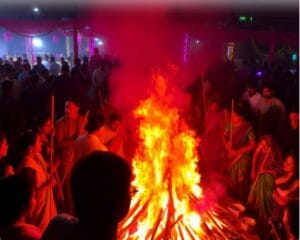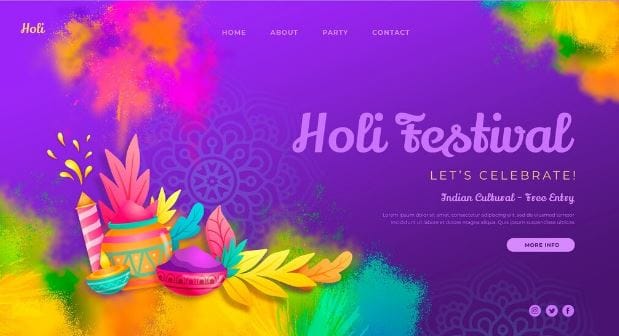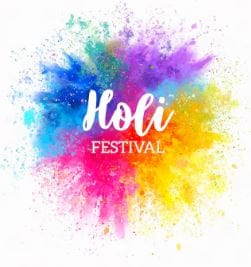Holi exists as the “Festival of Colors” and people observe this lively celebration mostly in India and Nepal and also throughout global South Asian communities. The festival arrives to bring spring season and represents the victory of good elements alongside love and fresh beginnings. It started as a Hindu mythological event which now stands as a major cultural celebration that unites people across religions through its communal festivities of happiness.

👉Cultural Significance :-
As a cultural tradition Holi provides people with a sacred moment to drop previous conflicts and rebuild social bonds. Through this festival people learn to forgive each other as they come together which serves as a strong social connection tool. Holi unfolds through two principal days starting with Holika Dahan the night before Holi followed by Rangwali Holi as the colored day.
Holika Dahan (Chhoti Holi)
⏩Story Behind Holika Dahan :- The sacred practice of Holika Dahan originated from the tale between Prahlad and Holika. The story of Hindu mythology shows King Hiranyakashipu who commanded his people to worship him instead of God. Prahlad proved his devotion to Lord Vishnu despite his father’s attempts to make him worship other than the god. Holika attempted to kill Prahlad by sitting next to him in a burning fire based on her divine protection from fire. The divine power saved Prahlad from the flames which consumed Holika because she died in the fire.
⏩Celebrations :- The night before Holi witnesses collective bonfire ceremonies where people perform ceremonies representing good triumphing over evil while eliminating negative forces. People perform prayer along with dancing and singing while they circulate around the fire during this special ritual.

Rangwali Holi (Dhuleti)
⏩Celebrations :- People mark the following day after Holika Dahan with Rangwali Holi through which they participate in the colorful custom of throwing gulal and water as they celebrate. The colorful spectacle symbolizes the arrival of springtime as well as the diverse spectrum of colors which spring introduces.
⏩Traditional Practices :- This celebration includes using water guns (pichkaris), water balloons together with colored powders for the festival. The festival combines musical performances and dancing with traditional sweet exchanges of thandai and gujiya.
👉Mythological Significance :-
The celebration of it exists within Hindu mythology because it contains multiple historic legends which explain its origins.
⏩The Story of Prahlad & Holika :- The story about Prahlad and Holika serves to show how good power defeats darkness. People observe Holika Dahan as a commemoration of this tradition.
⏩The Story of Lord Krishna & Radha :- Holi traditions in mythology contain the tale about Radha and her beloved Lord Krishna. According to tradition Krishna expressed sadness because his dark complexion created a distinct appearance from his beloved Radha. His mother solved the skin color discrepancy between Radha and Krishna by suggesting he apply colors to Radha during their Holi celebrations.
👉Social and Cultural Impact :-
Through its social and cultural impact Holi causes a deep influence on society.
⏩Unity & Harmony :- Holi serves as a festival that prompts society to unify and establish peace among all its members despite their distinctions. At this festival society sets aside its normal social structures which allows everyone to engage in equal participation.
⏩Economic Impact :- Holi creates economic benefits by stimulating sales of local festive goods including traditional sweets and colored powders and decorative products.
⏩Environmental Concerns :- As people celebrate it through the use of synthetic colors there exist environmental problems that include excessive water consumption. During the festival people work to introduce environmentally friendly colors while lowering the amount of water used.
👉Global Celebrations :-
Today it has become internationally recognized because major South Asian communities in the United States, the United Kingdom and Caribbean celebrate this festival. The traditional activities during such celebrations include big group events along with musical performances and traditional color-throwing rituals.
👉Conclusion :-
As a celebration, it represents the union of life with love and it embodies the victory of good elements over evil ones. Through this celebration people unite to create social harmony between each other. During the festival joy prevails but its true meaning lies in forgiveness while signifying fresh starts. Through global interconnectedness Holi distributes its vivid festivals alongside its unifying message through various cultures worldwide.

👉Symbolic Meanings of Holi Colors :-
Red :-
In Indian culture red carries the symbolic meaning of love together with passion and fertility. The colors carry special meanings in Hindu beliefs through their association with the sacred love tale of Krishna and Radha which portrays passionate devotion.
The festival color red holds important cultural meaning in Indian tradition because it represents both energy and vitality.
Yellow :-
Yellow symbolism in India signifies both happiness and peace together with prosperity. The Indian tradition considers turmeric sacred because of its healing properties.
Many Hindu divinities like Lord Vishnu and Lord Krishna show themselves wearing yellow clothing which signifies their auspicious nature in religion.
Blue :-
The divine and spiritual connection appears through blue symbolism which normally associates with Lord Krishna because he has blue skin. Blue represents both serenity and calmness and brings forth courage.
The color blue in Hindu culture carries a dual meaning of unending space because it symbolizes both the vastness of sky and ocean.
Green :-
The color green simultaneously represents fresh starts and springtime events together with peacefulness. During Holi spring’s arrival brings new beginnings symbolized through the green color.
During festival green serves as a cultural symbol for both harmony and growth which represents the new beginnings of the season.
Orange/Saffron :-
The hue of orange in religious symbolism connects to bravery together with giving up oneself as well as personal spiritual evolution. The sacral chakra associates with this hue and Hinduism recognizes it as sacred.
Yogis and gurus regularly choose saffron robes to indicate their spiritual development.
Purple :-
Purple color symbolism connects to three meanings about supreme peace wisdom and royal status. The crown chakra uses purple as its representation because it guides individuals toward spiritual enlightenment.
During the festival purple becomes prominent due to its association with luxury and power because people use it to create magical effects.
Pink :-
The color pink symbolizes prosperity and grace as well as hope. The beauty of the lotus flower together with its abundant nature inspires this color symbolism.
Pink serves as a subtle sign that represents fresh starts and restoration in cultural traditions.
The festival becomes more vibrant through colors that symbolize different cultural and spiritual and emotional elements of it.
💬Disclaimer :-
This Blog provides general information as an educational source only. The author uses their life experiences together with personal viewpoints to create all content. The author accepts no responsibility for damages or losses when users apply this information. The website information depends on your individual acceptance of personal risk when you use it. The information does not serve as professional guidance, so readers need to seek proper professional advice before implementing decisions from the provided content.
One Response